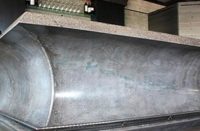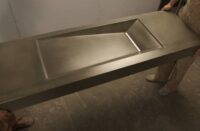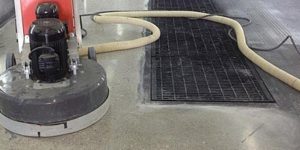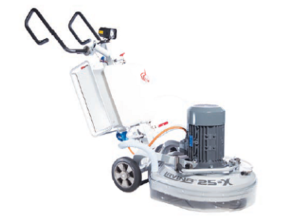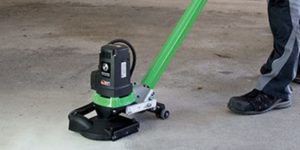Every concrete countertop fabricator is after a smooth, clean finish on his or her work, be it a kitchen island, fireplace mantle or sink basin. Achieving a flat, shiny surface often comes down to the type of grinder that’s used, and with so many machines on the market, many fabricators can feel overwhelmed by the choices.

Grinders vs. Polishers
First, there are machines that grind and machines that polish. The two are different – machines designed exclusively for polishing are smaller and lighter than grinders.
“Grinders are heavy, can take more abuse, and are for aggressive stock removal,” says Jeff Girard, president of The Concrete Countertop Institute. “The 400- to 3,000-grit stage is what I call polishing, which will build a sheen. You’re not removing any concrete.”
Experts also note that a machine’s output is determined more by the grit of the pad used than by the machine itself, and the higher the grit, the closer one gets to polishing, regardless of what machine you use.
That said, you now know a grinder is what you’re looking for, not a polisher. Now what?
Electric vs. Pneumatic
Countertop grinder shoppers must decide whether to choose a machine that’s powered by a cord plugged into an electrical outlet or one that’s motorized by air.
The consensus among experts is that pneumatic machines (into which air is blasted through a hose that’s attached to an air compressor) are the way to go, as the tools are lighter and carry no risk of electrocution.
Another negative aspect of electric tools is their weight – they’re generally more cumbersome than air-powered tools. While pneumatic grinders require an additional initial investment of roughly $1,000 to $3,000 for an air compressor, experts say the tools themselves don’t cost more than electric tools do, and they weigh much less (as little as 2 pounds).
But there is a downside to air-powered machines as well: An air compressor can be a costly investment, and they limit fabricators to working solely out of their shops. Since electric grinders can be used anywhere an outlet is found, they provide fabricators with more mobility, allowing them to grind and polish in clients’ buildings, for example.
How can fabricators decide what’s best? Colin Sparkman, a partner at Patina Concrete in Modesto, Calif., says the way your shop is set up, as well as the amount of work you do and where you do it, can be good indicators.
“We have a lot of outlets in our shop and a small staff, so electric works for us,” Sparkman says. “If you’re a huge shop with a large amount of production, you might go with air-powered.”
Girard concurs. “You have to ask yourself what you’re trying to do. Are you going to the job site? Then you need to go electric. Are you doing all of your work from an existing shop? Then I recommend going pneumatic.”
As electric grinders carry the risk of electric shock when used wet, experts recommend using an electric grinder that’s double-insulated and has a built-in ground fault interrupter.

Wet vs. Dry
The next question fabricators must ask themselves when choosing a grinder is whether they want to go wet or dry. Experts say the majority of countertop grinding and polishing is done wet, but that most fabricators will end up doing some dry grinding as well.
When grinders are used wet, water is fed through the machine and exits the center of the grinding disk(s), which preserves the life of the diamond pads used with the machine and allows workers to grind dust-free. And since they operate at high rpm, wet grinders can remove material about three to 10 times faster than dry grinders can, Girard says.
Also, all experts agree high-quality surfaces are easier to achieve with water. “You’ll get a cleaner polish,” says Buddy Rhodes, of Buddy Rhodes Studio in San Francisco. “It depends on what kind of a finish you’re going for.”
However, grinding with water produces slurry, which can create a big mess in the shop, and the presence of water on the concrete surface can mean slightly poor visibility. “The downside of wet grinding is that you’ll need enough space to handle the water, and you have to do something with the water – you can’t just flush it down the drain,” Girard says.
Dry grinding – while it produces dust – is a cleaner process and can be done on job sites. When selecting a dry grinder, choose one with an effective vacuum system to minimize dust, experts say, and keep in mind that without water, the machine’s diamond pads will wear more quickly.
Planetary vs. Single-Head
The third question fabricators may ask while building their grinding toolset is, do I need a planetary machine?
Planetary grinding/polishing machines contain multiple heads that cover a diameter of about 12 inches and spin clockwise and counterclockwise. They require minimal skill to operate and result in a super-flat finish. “With heads that spin in opposite directions, you’ll get a better polish and it won’t leave marks, and the operator of a planetary machine will experience less fatigue,” says Tom Fischer, president of Fishstone in Elgin, Ill.
While planetary tools are very useful on large spaces, such as floors, wide countertops and kitchen islands, they can’t be used on edges or narrow, oddly shaped areas like fireplace mantles, sinks and toilets. So fabricators should view a planetary tool as a supplementary investment, as they’ll still need to buy a single-head hand grinder.
Experts say if you’re working on large pieces of concrete on a regular basis, a planetary tool can be worth the cost.
“They’re pretty good if you have a large space to cover, but they’re costly and make a lot of noise,” Rhodes says. “If you’ll use it professionally on a day-to-day basis, it’s good to have in your toolbox. They give you a smooth, flat surface.”
Other Considerations
What else should fabricators think about on their quest for the most suitable grinding tools? For one, weight and comfort – if you’ll be using a machine every day, one that’s easy to maneuver and on the lighter side might be best. “When you’re looking at them, think about the way the tool feels when you pick it up,” Sparkman says.
While you can’t know exactly how well a tool will perform until it’s used, reputation can be a good indicator. “Go with the ones that are tried and true,” says Steve Kisling of Patina Concrete. And experts agree that buyers get what they pay for. Cheaper models exist, but they’re more likely to break down and be less comfortable to use.
If grinding and polishing work on curved, hard-to-reach spaces such as sinks and toilet bowls is a regular part of a fabricator’s routine, a grinder that holds a small pad (about 3 inches) and comes with a detachable extension device can come in handy. Diamond hand-polishing pads are also useful on these types of surfaces and on any area that could use a quick touch-up. “(Hand-polishing pads) are essential,” Girard says. “At about $80 a pack, they’re a no-brainer.”
www.buddyrhodes.com
www.concretecountertopinstitute.com
www.concretecountertopsupply.com
